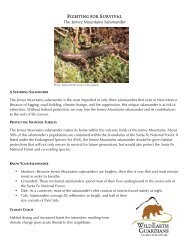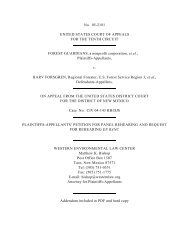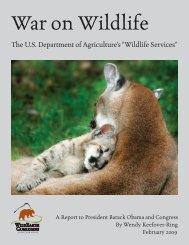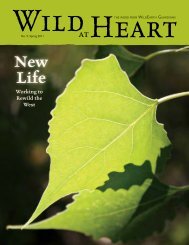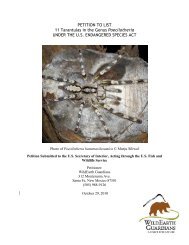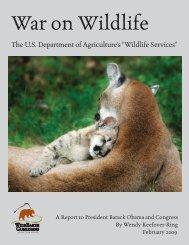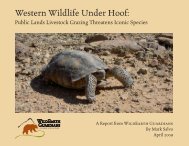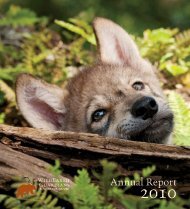Notice - WildEarth Guardians
Notice - WildEarth Guardians
Notice - WildEarth Guardians
Create successful ePaper yourself
Turn your PDF publications into a flip-book with our unique Google optimized e-Paper software.
West and has members who are harmed by the failure of the Administrator and the EPA to<br />
follow through with duties under the Clean Air Act to ensure that clean air SIPs are timely<br />
submitted and acted upon to ensure adequate protection of air quality and public health and<br />
welfare nationwide.<br />
Clean Air Act Requirements<br />
On March 12, 2008, the EPA promulgated revised NAAQS for ozone, a harmful air<br />
pollutant that in small concentrations can trigger asthma attacks, aggravate emphysema, and<br />
permanently damage the lungs of children. See 73 Fed. Reg. 16436-16514 (March 27, 2008).<br />
The EPA set a new standard limiting ozone concentrations to no more than 0.075 parts per<br />
million over an 8-hour period. See 40 C.F.R. § 50.15.<br />
In accordance with Section 110(a)(1) of the Clean Air Act, States are required to submit<br />
SIPs to attain and maintain the NAAQS within three years of the promulgation or revision of a<br />
NAAQS. See 42 U.S.C. § 7410(a)(1). 1 In assuring that SIPs attain and maintain the NAAQS in<br />
accordance with Section 110(a)(1), States must ensure their SIPs include requirements set forth<br />
under Section 110(a)(2). See 74 U.S.C. § 7410(a)(2). These requirements, include, but are not<br />
limited to:<br />
• Enforceable emission limits (42 U.S.C. § 7410(a)(2)(A));<br />
• Establishment and operation of monitoring systems (42 U.S.C. § 7410(a)(2)(B));<br />
• Enforcement programs (42 U.S.C. § 7410(a)(2)(C));<br />
• Limits on interstate transport (42 U.S.C. § 7410(a)(2)(D));<br />
• Assurances of adequate authority (42 U.S.C. § 7410(a)(2)(E));<br />
• Monitoring of emissions from stationary sources (42 U.S.C. § 7410(a)(2)(F));<br />
• Authority to exercise emergency powers (42 U.S.C. § 7410(a)(2)(G));<br />
• Provisions that provide for the revision of SIPs (42 U.S.C. § 7410(a)(2)(H));<br />
• Meet nonattainment SIP requirements within nonattainment areas (42 U.S.C. §<br />
7410(a)(2)(I));<br />
• Meet consultation, public notification, and Prevention of Significant Deterioration<br />
(“PSD”) requirements (42 U.S.C. § 7410(a)(2)(J));<br />
• Provide for the modeling of air quality (42 U.S.C. § 7410(a)(2)(K));<br />
• Establish permitting fees (42 U.S.C. § 7410(a)(2)(L));<br />
• Ensure consultation and participation by local entities (42 U.S.C. §<br />
7410(a)(2)(M)).<br />
These requirements are collectively referred to as the “general infrastructure elements.” 2<br />
U.S. EPA, State Implementation Plan Overview,<br />
http://www.epa.gov/air/urbanair/sipstatus/overview.html (last viewed Sept. 12, 2011).<br />
See<br />
1 The definition of States under the Clean Air Act includes the District of Columbia, Puerto Rico, Virgin Islands,<br />
Guam, American Samoa, and the Northern Mariana Islands. See 42 U.S.C. § 7602(d).<br />
2 Although the requirements of Section 110(a)(2)(D) are often referred to as “good neighbor elements” due to the<br />
fact that they require that SIPs limit the transport of air pollution to downwind states.<br />
2



